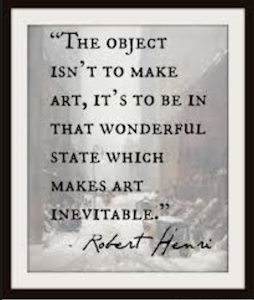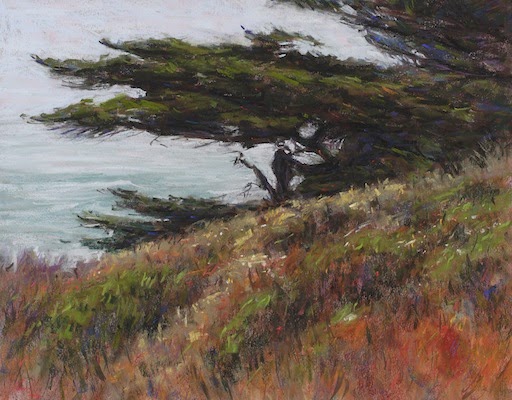Lorenzo Chavez’ suggestive renderings and fluent technique have earned him numerous awards and many devoted collectors throughout the United States, and he is considered by many to be the West’s premier pastel painter.

Lorenzo returns to the Hudson River Valley Art Workshops from May 3 to 9, 2015 to teach a Studio and plein air Workshop, Field Study to Studio Concepts, in pastels and oils.

How long have you been teaching and what got you started teaching?
I first starting teaching Plein Air Workshops in 1993 when I was recommended by one of my artistic heroes, Ned Jacob, to a gallery in Aspen, Colorado that was doing workshops. The workshops were during the summer months in the Colorado Rockies. I am still good friends with one of the students I met there. He said I was shaking when I did my first demos. I probably was. He continues to take my workshops, but now he says, “You’re like an old pro at teaching workshops.”

What is your favorite part about teaching?
My favorite part about teaching is the people I meet and their love of painting and passion for learning. That is inspiring.
What would you tell your prospective students are three best reasons for taking a workshop?
The 3 best reasons I would tell someone to take a workshop are:
How great it feels to do something that is an investment in yourself.
The interesting people you will meet and possible new friendships of like-minded folks.
To paint out of our comfort zones can be a bit scary, but once we do it is immensely rewarding.
What are you currently working on in your own art?
I recently returned to an earlier passion of drawing and painting the figure. I find it a great and stimulating challenge which continues to make me a better overall artist. I am working on some figures that are based on the Pueblo Cultures of New Mexico. What fun, and how inspiring it has been.
Of course, I absolutely love painting the landscape and I am working on some studio and plein air paintings that will be part of a series of exhibitions for the Plein Air Painters of America (an organization devoted to the advancement of plein air painting).
Where is your art currently being exhibited?
Six great galleries currently represent my work on a full time basis and I am involved in group exhibitions such as the Maynard Dixon Country Exhibition, the Legacy Gallery, Rims to Ruins Exhibition to benefit the Mesa Verde National Park Foundation, and several others.
Is your work represented in galleries, and if so, what hints would you give to artists looking for gallery representation?
In the workshops I have taught over the years, I have met a number of artists that want additional mentoring. The topic of getting into a gallery recently came up with a couple students. I told them it is important to visit the galleries you’re interested in. Make a list of five, or so, galleries you would love to have your art associated with and in areas you would love to travel and paint. Get to know the folks who run these galleries. Be visible and friendly; one never knows where it leads.
Do you sell your work in any online gallery?
Most good galleries have an online presence. Remember, selling artwork is a team effort and a business partnership between yourself and the gallery. Work with them, be honest, and lead collectors to your galleries.

What is your favorite art quote?
My favorite art quote is by Robert Henri. “The object is not to make art but to be in that wonderful state of mind where art is inevitable.”

Describe your studio.
For a landscape painter everything starts with being inspired by the great outdoors. The main focus of my workshops has been the study of plein air landscapes. That is where the magic happens. I teach concepts that help to clarify the landscape language, such as understanding the color of natural light, value planes, atmospheric perspective and how to simplify the landscape and create a compelling design from nature’s variety. My primary studio is a plein air set up under the wide-open sky.

Once indoors, we have unlimited time to play with the artistic elements to create even more captivating art from our studies from nature and imagination. My two indoor studios are both at our current home in Colorado. One is devoted to oil painting where I use a large Hughes easel. The pastel studio has an older upright easel I purchased years ago and has become a good friend. Close to the easel is an antique desk holding numerous pastels at the ready.

Name five of your “can’t do without” tools/products.
Buy the best quality equipment; it pays off in the long run. Tools of the trade I depend on are: a sketch book, pastels/oils, outdoor easels, sun block, a great pair of walking shoes and a good hat. However, the most important tool is the knowledge of how to construct a painting.

Read more of our recent Instructor interviews:
An Interview with Leah Lopez, Award-Winning Artist and Instructor
An Interview with Frank Francese, Watercolor Artist
An Interview with David Daniels: Artist in Watercolor + more
An interview with Judy Coates Perez, mixed media textile artist.
Interview with Liz Kenyon, Pastel Painting Instructor
Patti Mollica discusses creating her art, and teaching
An Interview with Kim English, Oil Painter
An Interview with Barbara Nechis, Watercolor Artist
An interview with Hollis Chatelain: Fiber Artist
An Interview with Natalya Aikens: Computer + Stitch = Art Quilt
Ruth Powers: Designing and Sewing for Picture Piecing




















 Where is your art currently being exhibited?
Where is your art currently being exhibited?





